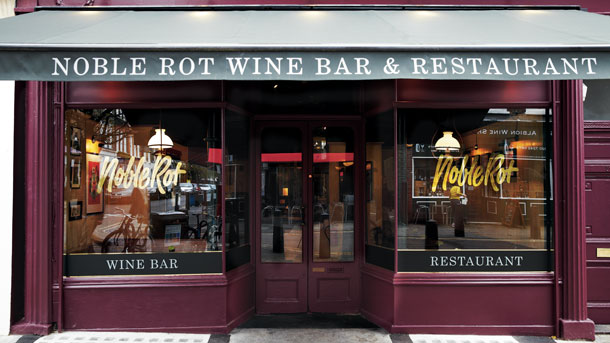Noble Rot: How to interest customers in good wine

Bad news, sommeliers (or good, depending on your view): the average Brit has revealed themselves to be completely clueless about wine. In a new poll released by booking platform OpenTable, nine out of 10 Brits default to house wine, and 70% of 18-24s say they don’t even know what a ‘sommelier’ is in the first place.
Just three in 10 people admit to feeling confident pairing wine with food, and just under one in 10 understand the wine terms ‘cloying’, ‘legs’, or ‘baked’.
But all is not lost – we caught up with Mark Andrew, co-founder London wine bar and restaurant Noble Rot, to find out how to make wine in restaurants more accessible and create a list that gets people interested.
1. Customer communication is paramount
Any restaurant worth its wine list knows that connecting with the customer is about more than just taking their order. Wine is no exception.
“Even if you have the product and the list, you’ve got to communicate to the customer why they should find it interesting and why they should want to participate,” says Andrew.
“You've got to speak the customer's language. When it comes to wine especially, it’s easy for this whole set of pompous vocabulary and way of talking to come over people, and they become very serious.
“Some people don't want to deal with that on a night out, so it’s a turn off. Immediately you’ve lost them. We only want to have a conversation with the customer based on who they are, and how they want to receive that information.”
2. Keep it simple
Wine doesn’t have to be all high-end vocabulary and esoteric tasting notes.
Just because only 30% of the OpenTable respondents know what ‘cloying’, ‘legs’, or ‘baked’ means, doesn’t mean that 70% are beyond hope. Indeed, Noble Rot uses no tasting notes at all.
“If we filled our wine list with tasting notes, firstly it would run to 1,000 pages, and also, it would remove the opportunity for that dialogue to happen between the server and the customer,” says Andrew.
3. Hospitality is paramount
While wine knowledge is a key way to connect with customers, it’s not the most important thing. According to Andrew, having hospitality in your blood is key.
“We're careful about who we hire,” he says. “We take the three-month trial period seriously, and managers report back about how performance, interaction, and tone.
“We can teach wine knowledge, but you can’t really teach that deep commitment to hospitality;, making sure that customers leave the space feeling better than when they arrive.
“We do allow everyone's personality to come through, but we are making a judgement on whether that person is 'Noble Rot', and whether they think like we do about the importance of making people feel fantastic.”
Mark Andrew: "Even if you have the product and the list, you’ve got to communicate to the customer why they should find it interesting"
4. Treat your wine like you treat your food
A good restaurant would never make their food an afterthought, and there is no reason why a customer who is interested in where their meat comes from can’t also be tempted by wine.
“People may hold their hands up, understandably, and say, ‘I'm great on food, but wine is not my area of expertise, so I'm going to bring an expert’," says Andrew.
“That idea in itself isn't a major issue, but they then invariably team up with a large supplier. Most restaurants wouldn’t dream of doing that with their food procurement. If you're going to do it, you need to engage with quality distributors, and not just one, ideally. You can't expect a bog-standard approach to give you anything other than bog-standard results.”
5. The staff have to care, too
Good conversations with customers start with good staff training and engagement – from the kitchen staff to the frontline front-of-house, says Andrew.
“They have to be involved with the wine programme you've put together, no matter how simple it is. They have to care and they have to taste the wine,” he explains.
“If the people who are the conduit between the house and the customer are not engaged and interested, then you're screwed from the word go. We spend an enormous amount of time on that side of things, so that everyone who pulls up a chair here is going to get an experience.”
6. ‘House’ doesn’t mean ‘horrible’
The OpenTable survey may have shown the standard house wine to be the most popular option, but this doesn’t necessarily need to be bad thing, Andrew says. Noble Rot may have a daily- and weekly-changing selection of other wines by the glass, but the house wines aren’t neglected.
“When we think about wines by the glass,” says Andrew, “We just ask ourselves, does it excite us, inspire us, is it true to where it comes from, does it have a story to tell, can we inspire our customers? If the answer is yes, we'll bang it on the list. We have the luxury of doing that.
“We have a house white, red, and Champagne because we never want to exclude people if they just want to come in for a glass. But they're not 'typical' house wines. The red is a Rioja – a wine most are familiar with – but unlike many from the region it’s young and fresh, not very woody, with low levels of sulphites. It’s a bit left field, and a gateway towards other wines with interesting stories to tell.”
Mark Andrew spoke to Joe Lutrario






















